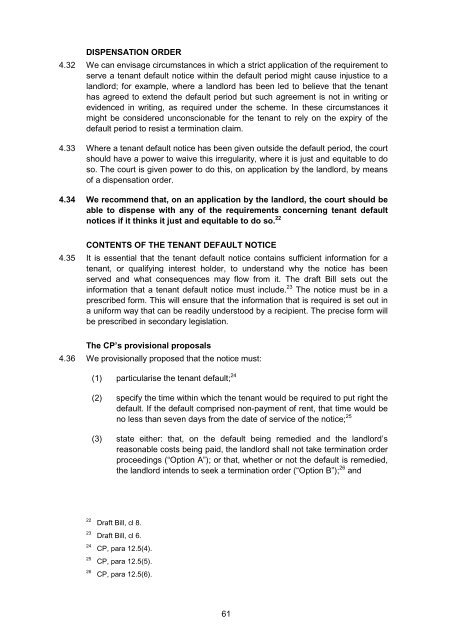Termination of Tenancies for Tenant Default - Law Commission
Termination of Tenancies for Tenant Default - Law Commission
Termination of Tenancies for Tenant Default - Law Commission
You also want an ePaper? Increase the reach of your titles
YUMPU automatically turns print PDFs into web optimized ePapers that Google loves.
DISPENSATION ORDER<br />
4.32 We can envisage circumstances in which a strict application <strong>of</strong> the requirement to<br />
serve a tenant default notice within the default period might cause injustice to a<br />
landlord; <strong>for</strong> example, where a landlord has been led to believe that the tenant<br />
has agreed to extend the default period but such agreement is not in writing or<br />
evidenced in writing, as required under the scheme. In these circumstances it<br />
might be considered unconscionable <strong>for</strong> the tenant to rely on the expiry <strong>of</strong> the<br />
default period to resist a termination claim.<br />
4.33 Where a tenant default notice has been given outside the default period, the court<br />
should have a power to waive this irregularity, where it is just and equitable to do<br />
so. The court is given power to do this, on application by the landlord, by means<br />
<strong>of</strong> a dispensation order.<br />
4.34 We recommend that, on an application by the landlord, the court should be<br />
able to dispense with any <strong>of</strong> the requirements concerning tenant default<br />
notices if it thinks it just and equitable to do so. 22<br />
CONTENTS OF THE TENANT DEFAULT NOTICE<br />
4.35 It is essential that the tenant default notice contains sufficient in<strong>for</strong>mation <strong>for</strong> a<br />
tenant, or qualifying interest holder, to understand why the notice has been<br />
served and what consequences may flow from it. The draft Bill sets out the<br />
in<strong>for</strong>mation that a tenant default notice must include. 23 The notice must be in a<br />
prescribed <strong>for</strong>m. This will ensure that the in<strong>for</strong>mation that is required is set out in<br />
a uni<strong>for</strong>m way that can be readily understood by a recipient. The precise <strong>for</strong>m will<br />
be prescribed in secondary legislation.<br />
The CP’s provisional proposals<br />
4.36 We provisionally proposed that the notice must:<br />
(1) particularise the tenant default; 24<br />
(2) specify the time within which the tenant would be required to put right the<br />
default. If the default comprised non-payment <strong>of</strong> rent, that time would be<br />
no less than seven days from the date <strong>of</strong> service <strong>of</strong> the notice; 25<br />
(3) state either: that, on the default being remedied and the landlord’s<br />
reasonable costs being paid, the landlord shall not take termination order<br />
proceedings (“Option A”); or that, whether or not the default is remedied,<br />
the landlord intends to seek a termination order (“Option B”); 26 and<br />
22 Draft Bill, cl 8.<br />
23 Draft Bill, cl 6.<br />
24 CP, para 12.5(4).<br />
25 CP, para 12.5(5).<br />
26 CP, para 12.5(6).<br />
61

















